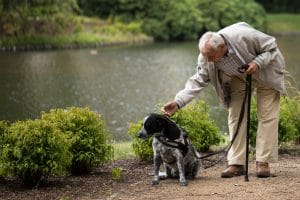 Dogs are man’s (and woman’s) best friend. They warm the heart, give you their undivided attention, and look at you with those wide sympathetic eyes. Until recently, walking a dog was thought to be a great form of exercise. Sadly, recent studies and stories are confirming that the risk of breaking a bone while dog-walking is on the rise.
Dogs are man’s (and woman’s) best friend. They warm the heart, give you their undivided attention, and look at you with those wide sympathetic eyes. Until recently, walking a dog was thought to be a great form of exercise. Sadly, recent studies and stories are confirming that the risk of breaking a bone while dog-walking is on the rise.
Delaware Public Media reported on March 12, 2019, on a disturbing new study by the University of Pennsylvania. The study found that that Americans who are more than 65 years-of-age and walk their dog on a leash are suffering twice as many fractures as they did in 2004.
The Penn study team examined federal injury data at 100 emergency centers nationwide. The number of fractures in the JAMA Surgery study showed that there were 4,396 dog-walking fractures in 2017 comparted to 1,671 such fractures in 2004.
The study was started because fractures of all types are more common with the elderly. The most common type of fracture, according to Penn associate professor of orthopedic surgery, Dr. Jaimo Ahn, is an upper arm fracture. The upper arm is normally the part of the body people use to brace themselves if they fall. Nearly 20% of people also suffer hip fractures which can be dangerous for seniors because the combination of old age and the hip anatomy make it hard for the hips to heal. Odds are, Dr. Ahn says, that if you didn’t use a walking device before a fracture, you’ll need one after the fracture. If you did use a cane, the odds are you’ll need to switch to a walker if you have a fracture.
Why the increase in fractures?
It’s not clear why the number of fractures for senior dog walkers more than doubled. Dr. Ahn suspects that seniors are more active now which makes falls and broken bones more likely. Dr. Ahn suggests that seniors need to recognize the limits of their strength. He suggests better training for the dog so the dog doesn’t pull on the leash. Doges can easily move or lunge when they see another animal.
Dr. Tim Church, a Louisiana preventive medicine specialist says that “In the context of a population of close to 50 million people over 65 in the U.S., he says, 4,000 injuries signify a “relatively small incidence.” Both he and Dr. Ahn recognize that exercise, including walking the dog, does have its health benefits. Getting out of the house is also good for mental health.
One suggestion is for seniors is to take the dog to a dog park. At the dog park, the dog can run free without being tied to a leash – and, by extension, to the human holding the leash.
What happens if the fall wasn’t caused by the dog?
If you fall while walking your dog because of something the dog did, there is not much that can be done. If, however, you tripped over a broken piece of sidewalk, or slipped and fell on a dangerous walkway that was not marked as such, you may be able to make a claim for damages. The same is true if, for example, your elderly parent lives in a nursing home which allows pets. If he or she slips, trips, and falls over someone else’s dog, the nursing home itself could be liable, depending on the circumstances. It is best to speak with an attorney if you are not sure about whether or not you have a claim. The initial consultation is free, so it does not cost you anything to ask.
At Delius & McKenzie, PLLC we have been fighting for personal injury victims for more than 20 years. We file claims against property owners, manufacturers, drivers, nursing home, and anyone whose negligence causes you harm. We represent accident victims in Sevierville, Seymour, Gatlinburg, Pigeon Forge, and the surrounding Tennessee areas. Please call us at (865) 428-8780 or fill out our contact form to make an appointment if you need help.

Attorney Bryan E. Delius was born and raised in Sevier County, TN. He founded Delius & McKenzie more than 20 years ago, after receiving his JD from the University of Tennessee at Knoxville. He is admitted in Tennessee and in several federal court systems. Learn more about Bryan E. Delius.




